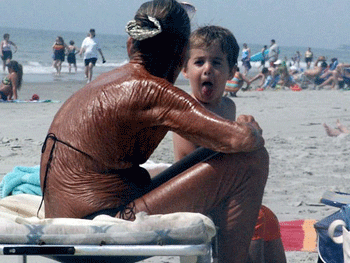 If this looks bad, try throwing in some crude oilIf you’re planning to hit the beach along the northern Gulf of Mexico, western Florida, or even much of the Eastern seaboard this summer, suntan lotion might not be enough to save you from an increased risk of skin cancer. Over the course of just a few hours on a sunny beach, crude oil can interact with UV rays on your body to cause a cancer risk similar to that of a strong sunburn. “It is going to cause a lot of oxidative damage to your skin cells,” says Jeff Short, a retired research chemist with the National Oceanic and Atmospheric Administration who spent years studying the toxic effects of the Valdez oil spill. “And you probaby aren’t going to know it.”
If this looks bad, try throwing in some crude oilIf you’re planning to hit the beach along the northern Gulf of Mexico, western Florida, or even much of the Eastern seaboard this summer, suntan lotion might not be enough to save you from an increased risk of skin cancer. Over the course of just a few hours on a sunny beach, crude oil can interact with UV rays on your body to cause a cancer risk similar to that of a strong sunburn. “It is going to cause a lot of oxidative damage to your skin cells,” says Jeff Short, a retired research chemist with the National Oceanic and Atmospheric Administration who spent years studying the toxic effects of the Valdez oil spill. “And you probaby aren’t going to know it.”
While sunlight can damage your skin cells directly (giving you a nice tan), adding crude oil to your skin catalyzes a different kind of unhealthy chemical reaction. Compounds in crude known as polycyclic aromatic hydrocarbons (PAHs) acquire energy from UV light and transfer it to oxygen molecules inside your skin cells, heating them up. “It literally burns your cells from the inside out,” says Short, who is now the Pacific science director for the environmental group Oceana. Chemists call the phenomenon “phyto-activated toxicity.” The result doesn’t look like a sunburn but can be equally damaging.
To date, studies of crude oil’s link to skin cancer have been limited to animals. “But based on those results,” Short says, “it’s something that humans should pay attention to.”
So how much crude on your skin is too much? Short says that if you don’t see oil in the water, it’s not going to cause significant sun damage to your skin. He’s more concerned about people whose bare hands and feet come into contact with balls of crude on sandy beaches. “It’s not that hard to get it all over you,” he says. “Believe me, I’ve done it many times.”














